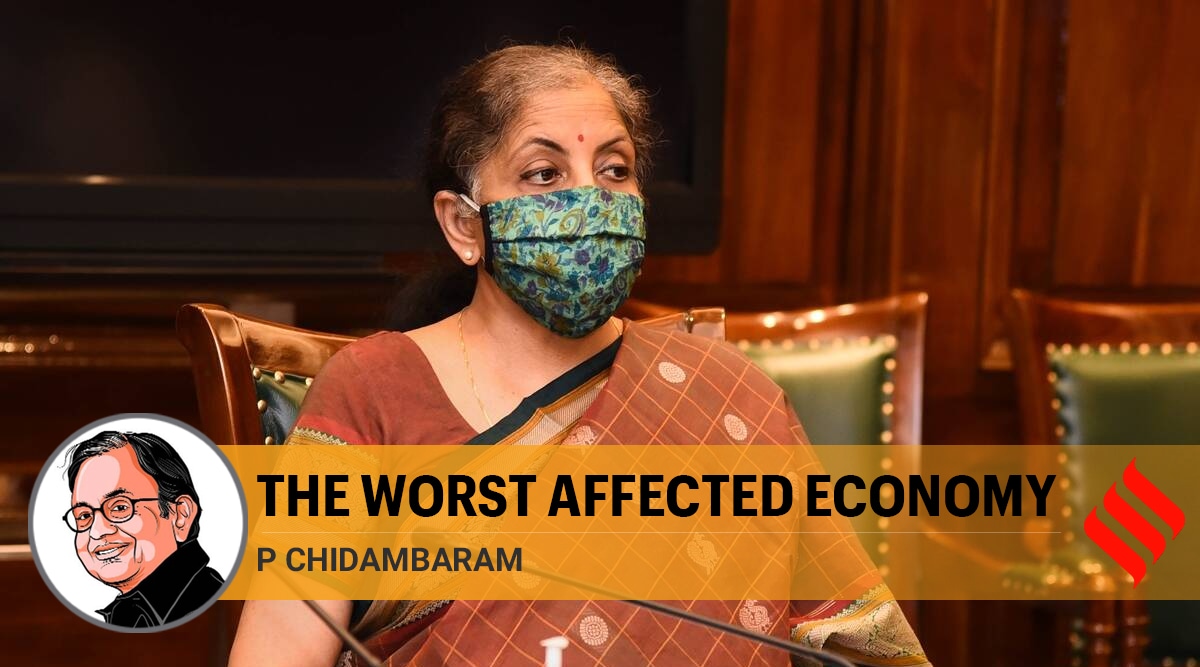In a barren desert without any sign of water, the Finance Minister and the Chief Economic Adviser saw green shoots!
Written by P Chidambaram | Updated: September 6, 2020 2:04:26 pm
Source : https://indianexpress.com
 Finance Minister Nirmala Sitharaman at the fourth edition of Business Reform Action Plan.
Finance Minister Nirmala Sitharaman at the fourth edition of Business Reform Action Plan.
Finally,
the fake narrative that was peddled by the government through 2019-20,
and even thereafter, has been exploded by the Central Statistics Office
(CSO). Those are indeed harsh words in a column but the realities are
harsher, the disdain of an uncaring government is so provocative, and
the suffering of the people is so enormous that one is compelled to use
harsh words. The intention is not to cause offence but to sound a loud
wake-up call to those who are in power and those who support those in
power.
The provisional estimates of GDP for the quarter April-June 2020 (Q1
of 2020-21), released by the CSO, tell us a grim tale. GDP in the first
quarter has declined by a whopping 23.9 per cent. That means, about one
quarter of the gross domestic output as on June 30, 2019, has been wiped
out in the last 12 months. Note that when output is lost, the jobs that
produce that output are lost, the income that those jobs provide are
lost, and the families that depend on those incomes suffer. According to
estimates made by the CMIE, between the economic slowdown and the pandemic,
at its peak, 121 million jobs were lost. These included regular
salaried jobs, casual jobs, and self-employment. If you wish to do a
reality check, just look around or ask questions of other households in
your street or neighbourhood.
At 23.9 per cent, India is the worst affected major economy (among the G-20) in the period April-June, 2020 (source: IMF).
Don’t Blame God
The only sector that has grown is Agriculture, Forestry and Fishing
at 3.4 per cent. The Finance Minister who blamed an ‘Act of God’ for the
decline should actually be grateful to the farmers and the gods who
blessed the farmers. Every other sector of the economy has declined
sharply, some precipitously. Manufacturing is down 39.3 per cent;
Construction by 50.3 per cent; and Trade, Hotels, Transport and
Communications by 47.0 per cent.
The estimates did not come as a surprise to any one who has closely
observed the Indian economy. What we have is an economic tragedy. It was
foretold by many economists, most recently by the RBI in its Annual
Report released last week. Look at the salient conclusions of the RBI:
– High frequency indicators that have arrived so far point to retrenchment in activity that is unprecedented in history;
– the total stimulus package (liquidity and fiscal measures) for G20
countries averaged 12.1 per cent of GDP (5.1 per cent of GDP for EMEs
and 19.8 per cent of GDP for AEs). India’s fiscal stimulus was about 1.7
per cent;
– the shock to consumption is severe, and it will take quite some time to mend and regain the pre-Covid-19 momentum; and
– a majority of respondents (in an RBI survey) reported pessimism
relating to the general economic situation, employment, inflation and
income.
Slide Predates Pandemic
The Indian situation is different from other countries’ because our
economic slide started long before the first case of Covid-19 was
identified. Our slide started with demonetisation. For eight successive
quarters in 2018-19 and 2019-20, GDP growth declined every quarter, from
a high of 8.2 per cent to a low of 3.1 per cent. This point was made a
zillion times, but the government pretended that India was the ‘fastest
growing economy in the world’! And in a barren desert without any sign
of water, the Finance Minister and the Chief Economic Adviser saw green
shoots!
We are still in a dark tunnel. Many economists believe that we can
find our way out of it, even at this stage, if the government took the
fiscal measures necessary to arrest the slide, boost demand/consumption,
and, consequently, revive production and jobs. The key is expenditure —
government and private consumption expenditure. It does not matter how
much is spent under which head as long the money is found and spent. The
government can find the money from many sources — disinvestment, more
borrowing by relaxing the limits under the FRBM Act; using the generous
funds to fight the pandemic promised by the IMF, World Bank Group, ADB
and others (USD 6.5 billion); and, as a last resort, monetising part of
the deficit.
Three Bold Moves
Part of the money must be transferred in cash to the poor; part
should be used for government capital expenditure in infrastructure;
part used to bridge the GST compensation gap; and part used for
re-capitalising banks and enabling them to lend. Once there is an
indication of revival of demand, private corporates, that are cash-rich
and have de-leveraged, will invest and produce.
The next bold move should be to use the mountain of food grain to put food in the homes of poor families and to pay wages-in-kind to start massive public works. The godowns will be full again soon thanks to the record-breaking harvest expected this year.
The third big move will be to decentralise powers to the states and
empower them financially. The Centre should abandon its ill-timed
attempt to interfere with agricultural produce marketing, regulate
supply of essential commodities, and control district central and urban
cooperative banks. One Nation, One Everything is a very bad idea.
My proposals do not factor two unknowns — the course of the pandemic and the intentions of China —because, as I write, they remain unknowns.

No comments:
Post a Comment